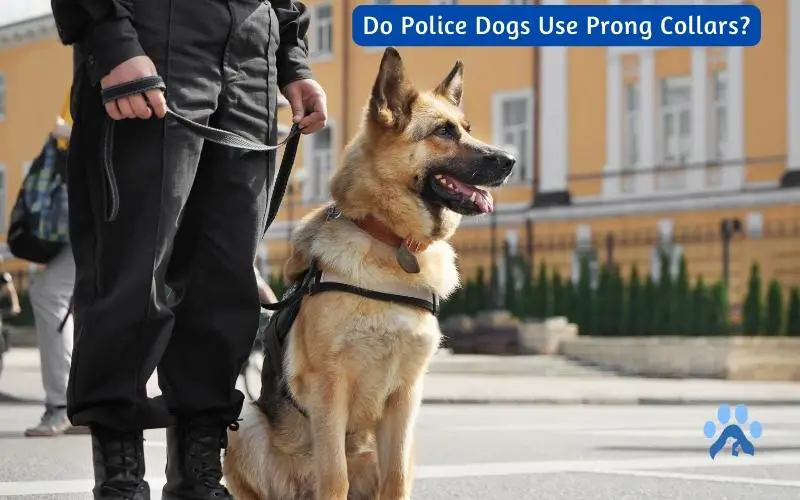A lot of thinking and labor goes into training and working with police dogs.
It is essential to ensure that the animal is well-trained and well-cared for to perform its duties effectively. One of the topics that often comes up in discussions of police dog training is, “Do police dogs use prong collars?“
Yes, prong collars are used by some police dog trainers to help control their animals and prevent them from pulling on a leash. However, their use is controversial, and there are strong opinions on both sides.
In this blog post, we will explore the use of prong collars by police dogs and examine their pros and cons. We will also discuss the alternatives to using prong collars and how they can be used safely and effectively.
How Prong Collars Are Used in Training Police Dogs?
Prong collars are an effective tool for training police dogs, as they allow for a higher level of control and safety for the dog and its handler. The collars are designed to provide gradual pressure when the dog is being trained, allowing the handler to convey commands with minimal effort.
When appropriately used, prong collars can provide a powerful training aid while keeping the dog safe and comfortable.
Plus, if used with other training methods, prong collars can be invaluable for quickly building a trusting relationship between the police dog and its handler.
To be used properly and efficiently, prong collars demand a high level of understanding and ability.
The Pros and Cons of Using Prong Collars for Police Dogs
Police dogs, also known as K-9s, are invaluable to law enforcement. They are trained to assist in various tasks, including search and rescue, detecting illegal substances, and apprehending suspects.
One of the methods used to train K-9s is prong collars.
Prong collars provide a corrective measure for teaching and reinforcing obedience, but it is crucial to understand their pros and cons.
So, let’s explore these collars’ potential benefits and drawbacks for police dogs.
Here’s all you need to know,
Benefits of Using Prong Collars
Controlled Corrections – Prong collars provide controlled corrections when needed. This allows the handler to give their dog the correct amount of pressure during training without causing pain or suffering.
It also helps ensure the dog understands what they are being asked to do and can respond quickly and appropriately in stressful or dangerous situations.
Consistency – Using a prong collar helps maintain consistency in training and reinforces commands quickly.
This type of collar allows handlers to immediately correct behavior, ensuring the exact expectations and results are achieved each time a command is given.
Durability – Prong collars are designed to last through intense training scenarios and challenging environments without breaking down or losing effectiveness over time.
This makes them an ideal choice for law enforcement K9s who may need to work under challenging conditions regularly.
Comfort – Contrary to popular belief, prong collars provide comfort for the handler and the dog. The ergonomic design ensures that the collar fits securely around the dog’s neck without causing any discomfort or irritation.
It also provides much-needed stability during rigorous activities such as tracking and apprehension work, ensuring that handler and canine remain safe.
Drawbacks of Using Prong Collars
When outfitting police dogs with collar restraints, prong collars have been a go-to choice for many years.
However, the drawbacks of using prong collars on police dogs have become increasingly apparent.
Several potential risks are associated with this type of collar, including physical and psychological damage to the animal.
For starters, prong collars can cause physical distress to the dog if used incorrectly or excessively. The sharp edges of the collar can create abrasions and lesions on the dog’s neck and cause breathing difficulties if it is too tight.
Additionally, the pain caused by these collars can increase aggressive behavior from the animal. This could potentially be dangerous for the handler and other nearby people.
Lastly, prolonged use of prong collars can have a negative psychological impact. It could desensitize dogs to pain and discomfort, leading them to become more aggressive when faced with a stressful work environment.
This can make it more difficult for them to carry out their responsibilities as police dogs efficiently.
Given these potential drawbacks, it is clear that alternatives should be explored when it comes to outfitting police dogs with collar restraints.
Using softer materials like leather or nylon, proper training techniques, and positive reinforcement methods can help ensure that police dogs can do their job safely and effectively without fear of physical or psychological harm.
Alternatives to Prong Collars for Training Police Dogs
There are several alternatives to prong collars for training police dogs, including:
- Flat collars are the most basic type worn around the dog’s neck. They are made of leather or nylon and are a good option for dogs that respond well to verbal commands.
- Martingale collars: These collars are similar to flat collars but have a mechanism that tightens the collar when the dog pulls, preventing it from slipping out of the collar.
- Halti collars can control a dog’s head, giving the handler movement control. They are frequently used for dogs with leash-pulling issues.
- Remote training collars: These can be controlled by a remote transmitter, allowing the handler to correct the dog from a distance. They are frequently applied to behavior modification and training.
- Training using positive reinforcement: This technique encourages desired behaviors by rewarding them with treats or praise. So, you may try this out too.
The usage of any collar, including the substitutes listed above, must be done carefully and under the supervision of a trained specialist.
Conclusion
So, do police dogs use prong collars? Prong collars are one of the many tools used by police dog handlers to train and control their working animals.
They are practical tools when used properly but can cause harm if misused.
For this reason, police dog handlers should use their best judgment to determine if a prong collar is the most suitable option for their dog’s training.
Plus, a handler must understand the proper use and be willing to use other training and control methods before using shock collar training for police dogs.
Frequently Asked Questions
What kind of collars do police dogs use?
Police dogs typically use collars made of leather or nylon, with some designed specifically for K-9s.
These collars are designed to stand up to the most challenging conditions and are strong enough to withstand the strain of a dog being pulled or held back by its handler.
They also feature metal buckles and D-rings for attaching identification tags, leashes, and other items.
Why do police use prong collars?
Police officers use prong collars to help maintain control of a canine unit in a high-stress environment.
The prong collar is designed to provide a humane and effective correction when the dog is pulling, lunging, or exhibiting other undesirable behaviors. It provides even pressure around the neck and is not intended to cause pain or harm.
When used correctly, the prong collar can be an effective training tool, allowing the handler to provide quick and consistent correction.
Does Cesar Millan use a prong?
Cesar Millan is a widely known and respected animal behaviorist, and his approach to dog training has become widely popular in recent years.
Millan does not recommend using this type of tool when using a prong collar.
His philosophy is to focus on positive reinforcement training techniques rather than tools that may cause discomfort or pain to the dogs.
Millan believes in creating a healthy relationship between dog and owner and that using a prong collar can be counter-productive to this goal.
He instead recommends using a gentle leader, a type of head halter that fits over the dog’s muzzle and allows the owner to have control while keeping the dog comfortable.
Are police dogs trained with shock collars?
Shock collars are used in some cases to train police dogs. However, there are better methods than this. These collars can harm a dog’s welfare and lead to aggression, depression, and fear.
Positive methods such as treats, praise, and reward-based reinforcement are commonly used in police dog training. Shock collars have also been known to distract a dog from the task at hand, leading to issues with focus and concentration.
While other training methods are more time-consuming, they result in a better-trained dog and a better police presence.
What harnesses do police dogs wear?
Harnesses are among the essential pieces of equipment necessary to keep police dogs safe and comfortable while in service. A good police dog harness should be lightweight and adjustable, allowing for a secure and snug fit.
It should also be made of durable and breathable materials, such as nylon or leather, with straps that can be easily adjusted.
The harness should also feature a handle for the handler to grab the dog quickly and secure places to attach leads, tracking devices, and identification tags.



